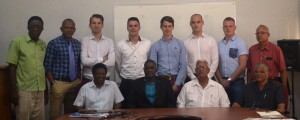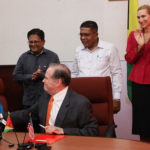
Ministers of Agriculture and Public Infrastructure Noel Holder and David Patterson accompanied by Major General (retired) Joe Singh, Deputy Mayor Sherrod Duncan and NDIA CEO Freddy Flatts, and other agency representatives with the team from the Netherlands who will be developing the hydraulic model for Georgetown.
A seven member team from the Delft University of Technology in the Netherlands will be in Guyana for the next seven weeks carrying out several studies and offering their findings as recommendations to the Government of Guyana on additional measures that can assist with drainage in Georgetown.
At a commencement ceremony today held in the main Boardroom of the Ministry of Agriculture, the team was given a chance to meet and interact with Ministers of Agriculture and Public Infrastructure Hon. Noel Holder and Hon David Patterson respectively. Five individuals of the seven member team are already in Guyana and are scheduled to commence work today.
Chief Executive Officer (CEO) of the National Drainage and Irrigation Authority Mr. Fredrick Flatts, spoke of the far way in which the talks among the two governments have evolved.
“One of the recommendations made by the team was to remodelling of the drainage catchment- some of the drainage catchments in Georgetown, in order to make the different levels of rainfall predictable.” Mr. Flatts said.
Minister of Public Infrastructure, Honourable David Patterson, during his remarks highlighted that Guyana’s drainage system has been operating on historic knowledge. “This approach has worked fairly well in the past however, it was unscientific and was prone to human errors. This approach makes our system unsafe as well as inefficient. While we value the experience of our staff we believe that modernization is very vital in order for us to improve our drainage system.” Minister Patterson said.
Also speaking at the ceremony was Mr. Maxwell Jackson the head of the Civil Engineer Department of the University of Guyana.
“The University of Guyana is being viewed as the sustainable arm of this exercise-at least I’m advocating that because our student body and our academic staff would be able to continue to enhance the model, to keep it going, to test it as it prolongs because the model would have to be monitored and data would have to be added. So as regards to continuity and the sustainability of this exercise, we at the University of Guyana will be taking up this challenge.” Mr. Jackson said.
The University of Guyana (UG) is engaged in this project by having some of its students participating in the exercise after the 2005 flood and a visit from the US. Army Core who carried out some hydraulic modelling.
The Disaster Risk Reduction (DRR) team that visited Guyana in November 2015 reported that Guyana’s response to flood related problems have often been reactive after a crisis has occurred and as a result suggested that Guyana adopt a more proactive approach by shifting to a more long term planning in the construction and maintenance of the drainage infrastructure and to upgrade our hydraulic modelling capabilities.
Agriculture Minister, Honourable Noel Holder while delivering remarks encouraged the Guyanese engineers that will be working with the DRR team to make the most of the opportunity to build their knowledge-base on hydraulic drainage models so that they can be trail blazers in this field and be able to replicate the knowledge gathered.
“Water management is a critical area of focus for the Ministry of Agriculture since most of our agriculture is practiced in the low lying area of regions 2, 3, 4, 5 and 6. The effects of proper drainage have positive impacts from an agricultural perspective; some of these include salinity control, flooding, crop yields, soil erosion and water supply among others. While we utilize natural drainage systems, these channels are not sufficient. Improved drainage methods and systems are necessary, thus, this initiative and the work of the National Task Force is timely and necessary for the socio-economic growth and well-being of the people of Georgetown and the country as a whole.” Minister Holder indicated.
Minister Holder also reiterated that the government of Guyana welcomes collaborations of this magnitude as collaborations such as this would better enable countries to accomplish more while ensuring better use of scarce resources, reduce duplication of effort, improve communication, understanding and trust among/between agencies.
Also speaking at the ceremony was Mr. Colvern Venture, City Engineer from the Georgetown M&CC. He indicated that over the years the council has been trying very often to conduct studies on how the drainage system in the city can be improved with the many expansions in the city and persons having to take up more space in Georgetown as it relates to buildings.
“The drainage system needs to be restudied. It can no longer work based on these developments-there is need for improvement and there is need for studies to be done to see where we could effectively improve our drainage network where we will have to probably create catchments within the city.” Mr. Venture explained.
Mr. Venture also indicated that the study that the DRR team will be conducting will be expanded to focus on the country as a whole. Given the recent drainage work carried out by the council and the Ministry of Public Infrastructure, there have been great signs of improvement in the drainage system of Georgetown.
During his closing remarks, Chairman of the National Task Force Secretariat Major General Joseph Singh (retired) pointed to the fact that water harvesting is also an important system that needs to be developed as part of the management of Guyana’s natural resources.
He added that “With limited budgets, we are aiming for targeted interventions- early warning and targeted interventions. Early warning based on the spread sheet data that will be compiled on an ongoing basis. I am hoping that those who are going to be the beneficiaries of this training and sustaining this process recognise that it is not just about compiling data and putting it in a model but also transmitting information in a timely manner so that decisions can be made with targeted interventions.”
While here, the team will be addressing three components: Developing a systematic approach for modelling the hydraulic system in Georgetown, carrying out the flood risk assessment and the structure and hydraulic component of Guyana’s drainage system. The goal of the project is to develop and test an approach for modelling the hydraulic system in Georgetown. For developing the model and properly interpreting it, an example model and an assessment of the hydraulic system and its relevant components will be made.
The team will also be tasked with modelling two of the main drainage catchment systems in Georgetown which will serve as a management and research tool to improve the drainage system in Georgetown. The National Task Force in collaboration with the Georgetown Mayor and City Council (M&CC) and other stakeholders have identified the Liliendaal and the South Ruimveldt catchments in Georgetown for modelling. Based on their geographical location, among other factors, these were seen as the most suitable catchment systems to be modelled at this time.
Transfer of Technology
Local engineers from the NDIA, the Ministry of Public Infrastructure, GuySuCo, M&CC, University of Guyana, Central Housing and Planning Authority will be working along with the team from the Netherlands to set up and utilize the drainage model. In the final week of the project most of the effort will be ensuring that the work carried out over the period reaches all the relevant partners. There will be a series of meetings, presentations and reports on the work done and suggestions for long term interventions to flooding in Georgetown.
The team was referred to Guyana by a previous DRR team that visited the country last year to carry out initial studies on Guyana’s drainage system. The seven member team consists of Mr. Joost Remmers, Mr. Ruben van Montfort, Mr. Siebe Dorrepaal, Mr. Peter Vijn, Mr.Jos Muller, Mr. Thijmen Jaspers Focks and Mr. Martijn van Wijngaarden who are in the process of achieving their master’s degree in Hydraulic Engineering and Structuring Engineering at the Delft University. While here, the DRR team will be working along with specialists in the field of engineering from the University of Guyana, the Ministries of Agriculture and Public Infrastructure and the National Task Force.





